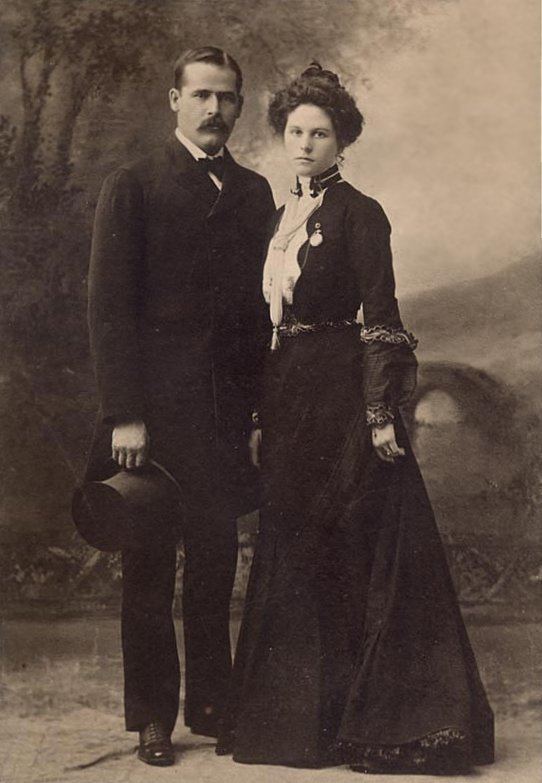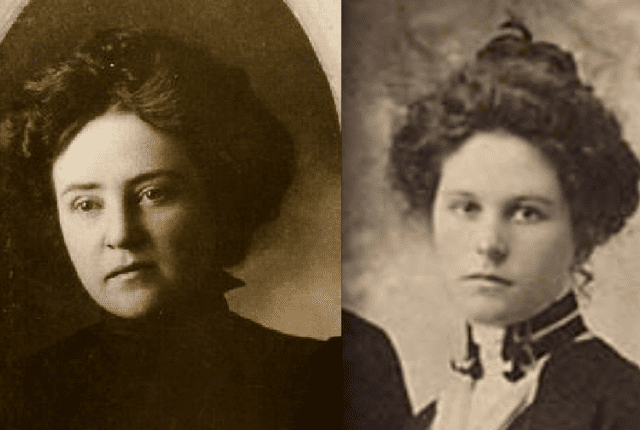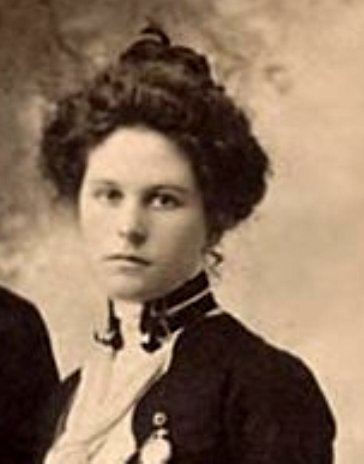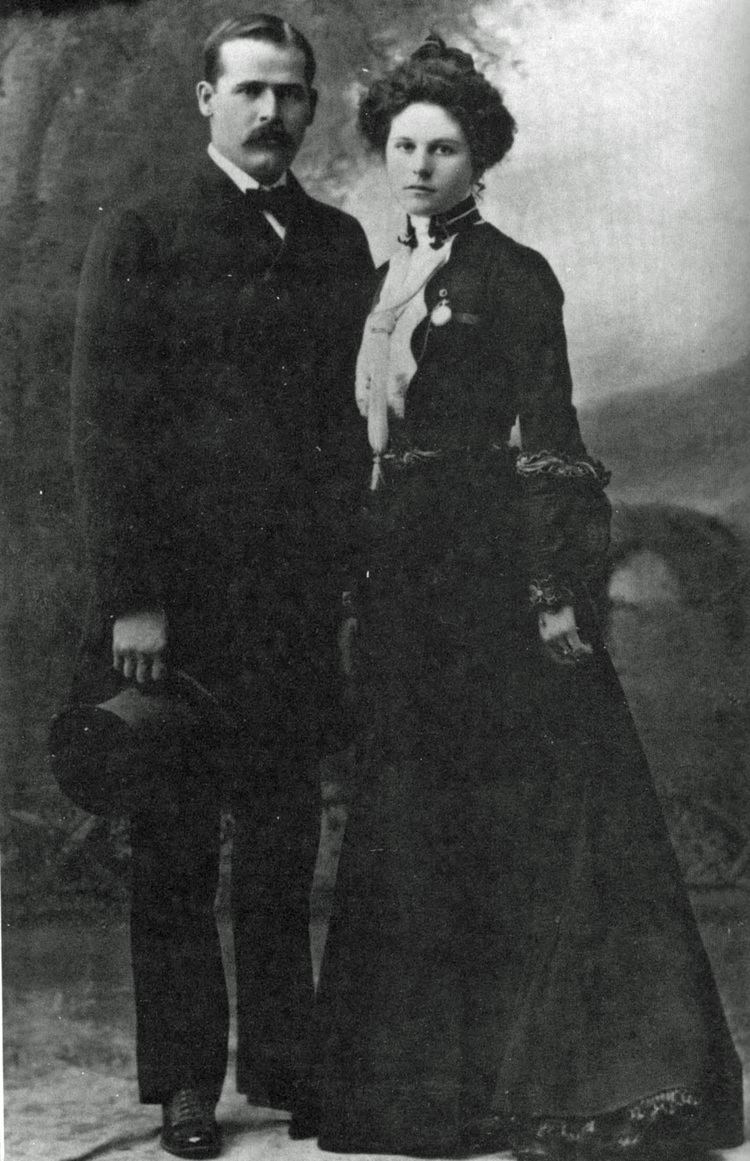Name Etta Place | Parents Annie Place | |
 | ||
Spouse Sundance Kid (m. 1901–1908) Similar People | ||
Etta place slide show by gerald kolpan
Etta Place (c.1878 – ?) was a companion of the American outlaws Butch Cassidy (real name Robert LeRoy Parker) and the Sundance Kid (Harry Alonzo Longabaugh), both members of the outlaw gang known as the Wild Bunch. Principally the companion of Longabaugh, little is known about her; both her origin and her fate remain shrouded in mystery.
Contents
- Etta place slide show by gerald kolpan
- What happened to Etta Place and the wild bunch
- Life with the Sundance Kid
- Mysteries
- Ethel Bishop
- Ann Bassett
- Eunice Gray
- Madaline Wilson
- Life after Longabaugh
- Fact timelines generally accepted by historians
- Media depictions
- References

The Pinkerton Detective Agency described her in 1906 as having, "classic good looks, 27 or 28 years old, 5'4" to 5'5" [163–165 cm] in height, weighing between 110 and 115 lb [50 and 52 kg], with a medium build and brown hair."

What happened to Etta Place and the wild bunch
Life with the Sundance Kid

According to a Pinkerton Detective Agency memorandum dated July 29, 1902, she was "said ... to be from Texas", and in another Pinkerton document dated 1906, she is described as being "27 to 28 years old", placing her birth between 1878 and 1879. A hospital staff record from Denver, where she received treatment in May 1900, reports her age as "22 or 23," putting her birth year at 1877 or 1878.

Even her real name is a mystery; "Place" was the maiden surname of Longabaugh's mother (Annie Place) and she is recorded in various sources as Mrs. Harry Longabaugh or Mrs. Harry A. Place. In the one instance where she is known to have signed her name, she did so as "Mrs. Ethel Place". The Pinkertons called her "Ethel", "Ethal", "Eva" and "Rita" before finally settling on "Etta" for their wanted posters. Her name may have become "Etta" after she moved to South America, where Spanish speakers could not pronounce "Ethel".
In February 1901, Etta Place accompanied Longabaugh to New York City, where at Tiffany's jewelers they purchased a lapel watch and stickpin, and posed for the now-famous DeYoung portrait at a studio in Union Square on Broadway. It is one of only two known images of her. On February 20, 1901, she sailed with him and Parker (who was now posing as "James Ryan," her fictional brother), aboard the British ship Herminius for Buenos Aires, Argentina.
There she settled with the two outlaws on a ranch which they purchased near Cholila in the Chubut Province of west-central Argentina. It comprised a four-room log cabin on the east bank of the Blanco River. Under a new 1884 law, they were granted 15,000 acres (61 km²) of adjacent land to develop, 2,500 of which belonged to Place herself, who has the distinction of being the first woman in Argentina to acquire land under the new act, as land ownership had previously been almost the exclusive preserve of men.
On March 3, 1902, she and Longabaugh returned to New York City on the SS Soldier Prince, probably to visit family and friends in the United States. On April 2, they registered at a Mrs. Thompson's rooming house in New York City. They toured Coney Island and visited his family (originally from Mont Clare, Pennsylvania, but by then living in Atlantic City, New Jersey). They also possibly traveled to a Dr. Pierce's Invalid Hotel in Buffalo, New York, for unspecified medical treatment. They then traveled west, where again they sought medical treatment, this time in Denver, Colorado. They returned to Buenos Aires from New York on July 10, 1902, aboard the steamer Honorius, posing as stewards. On August 9, she was with Longabaugh at the Hotel Europa in Buenos Aires, and on the 15th she sailed with him aboard the steamer SS Chubut to return to their ranch.
In the summer of 1904, she made another visit with Longabaugh to the United States, where the Pinkerton Detective Agency traced them to Fort Worth, Texas, and to the St. Louis World Fair, but failed to arrest them before they returned to Argentina. In early 1905, the trio sold the Cholila ranch, as once again the law was beginning to catch up with them. The Pinkerton Agency had known their precise address for some months, but the rainy season prevented their assigned agent, Frank Dimaio, from traveling there and making an arrest. Governor Julio Lezana issued an arrest warrant, but before it could be executed, Sheriff Edward Humphreys, a Welsh Argentine who was friendly with Parker and enamored of Place, tipped them off. The trio fled north to San Carlos de Bariloche, where they embarked on the steamer Condor across Lake Nahuel Huapi and into Chile.
By the end of that year, however, they were again back in Argentina; on December 19, 1904, Place took part, along with Longabaugh, Parker, and an unknown male, in the robbery of the Banco de la Nacion in Villa Mercedes, 400 miles west of Buenos Aires. Pursued by armed lawmen, they crossed the Pampas and the Andes and again into Chile.
Place had long been tired of life on the run and deeply lamented the loss of their ranch. At her request, on June 30, 1906, Longabaugh accompanied her from Valparaiso, Chile, to San Francisco, California, where she apparently remained while he returned permanently to South America. There is no evidence that Longabaugh and Place ever saw one another again after that.
Mysteries
Those who had met Place claimed the first thing they noticed about her was that she was strikingly pretty, with a very nice smile, and that she was cordial, refined and an excellent shot with a rifle. She was said to have spoken in an educated manner, and she indicated she was originally from the East Coast, although she never revealed an exact location.
Eyewitnesses indicated, years afterward, that Place was one of only five women known to have ever been allowed into the Wild Bunch hideout at Robbers Roost in southern Utah, the other four having been Will Carver's girlfriend Josie Bassett, who also was involved with Parker for a time; Josie's sister and Parker's longtime girlfriend Ann Bassett; Elzy Lay's girlfriend Maude Davis; and gang member Laura Bullion.
She was speculated to have once married a schoolteacher, and at least one person claimed Place, herself, said she was a teacher who abandoned her husband and two children to be with Longabaugh. The claim that she met the gang while working as a prostitute is also widely believed; some claim that Place was originally Parker's lover and became involved with Longabaugh later and that she met both while working in a brothel as a prostitute. Both of those claims are possible, as members of the Wild Bunch gang often alternated girlfriends.
It is possible that she met Parker and/or Longabaugh in the brothel of Madame Fannie Porter in San Antonio, which was frequented by members of the Wild Bunch gang. In fact, through Madame Porter's, several gang members met girlfriends who later traveled with them, including Kid Curry and prostitute Della Moore and Will Carver and Lillie Davis. Wild Bunch female gang member Laura Bullion is believed to have worked at the brothel from time to time.
Ethel Bishop
It has been suggested that Place's real name was Ethel Bishop, who lived at a similar establishment around the corner from Madame Porter's at 212 Concho Street. On the 1900 Census, Bishop's occupation was given as an unemployed music teacher. She was 23 then, born in West Virginia in September 1876. The Ethel Bishop hypothesis neatly combines the stories that she was a schoolteacher or that she was a prostitute in one person.
Ann Bassett
Another conjecture is that she was a cattle rustler named Ann Bassett (1878–1956) who knew and operated with the Wild Bunch at the turn of the 20th century. Both Bassett and Place were attractive women, with similar facial features, body frame, and hair color. Bassett was born in 1878, the same year Place was thought to have been born. Dr. Thomas G. Kyle of the Computer Research Group at Los Alamos National Laboratory, who performed many photographic comparisons for government intelligence agencies, conducted a series of tests on photographs of Etta Place and Ann Bassett. Both had the same scar or cowlick at the top of their forehead. Dr. Kyle concluded that there could be no reasonable doubt they were the same person. Historian Doris Karren Burton also investigated the lives of both women and published a book in 1992 claiming they were one and the same.
However, Bassett's and Place's chronologies do not align. Several documents prove that Bassett was in Wyoming during much of the time when Place was in South America. Bassett was arrested and briefly incarcerated in Utah for rustling cattle in 1903, while Place was in South America with Longabaugh and Parker. Bassett also married her first husband in Utah that year and, therefore, could not have been in South America during that time.
Eunice Gray
A once-popular theory held that she was Eunice Gray, who for many years operated a bordello in Fort Worth, Texas, and later ran the Waco Hotel there until her death in a fire in January 1962. Gray once told Delbert Willis of the Fort Worth Press, "I've lived in Fort Worth since 1901. That is except for the time I had to high-tail it out of town. Went to South America for a few years ... until things settled down." Willis conceded that Gray never claimed to be Etta Place; he merely made that connection on his own, given the similarities in their ages, and the period in which Gray said she went to South America coinciding with Place's time there. Gray was described as a beautiful woman, and Willis believed that Place and Gray held a striking resemblance to one another, but there were no known photographs of Gray from that period to compare with Place's. Then, in 2007, amateur genealogist Donna Donnell found Eunice Gray on a 1911 passenger list from Panama. Following that lead, she tracked down Gray's niece, who had two photographs of her: one taken at her high-school graduation circa 1896, and another taken in the 1920s. Comparing those photos to Place's, both agreed that Eunice Gray was definitely not Etta Place.
Madaline Wilson
Yet another theory posits that Place was actually Madaline Wilson, a girl in Fannie Porter's brothel. Sleuther Tony Hays notes that of the five girls in Fannie’s “boarding house," all were born in or around 1878-80. One girl, twenty-two-year-old Wilson, appeared in the 1900 census records of Bexar County, Texas, immediately beneath Madame Porter's name. Like Porter, Wilson was listed as being of English birth, immigrating to the United States in 1884 at the age of six. Hays theorizes that Wilson changed her name, and that her British accent, tempered by sixteen years in America, might be described as “refined.” All traces of Wilson disappeared after the 1900 census, after Place and Longabaugh left town.
Life after Longabaugh
There is still considerable debate over when Place's relationship with Longabaugh ended. Some claims indicate that Place ended her relationship with Longabaugh and returned to the United States prior to his death. Other claims indicate that the two remained romantically involved, and that she simply tired of life in South America. By 1907, she was known to have been living in San Francisco, but after that, the trail runs cold.
After Longabaugh's death, some believe that she returned to New York City, while other theories indicate she moved back to Texas and started a new life there. A Pinkerton report indicates that a woman matching Place's description was killed in a shootout resulting from a domestic dispute with a man named Mateo Gebhart in Chubut, Argentina, in March 1922. Another report indicates she committed suicide in 1924 in Argentina, while yet another report indicates that she died of natural causes in 1966.
In 1909, a woman matching Place's description asked Frank Aller (US Vice-Consul in Antofagasta, Chile) for assistance in obtaining a death certificate for Longabaugh. No such certificate was issued and the woman's identity was never ascertained.
There have been various additional claims about her life after Longabaugh died. One claim is that she returned to her life as a schoolteacher, living the remainder of her life in Denver, Colorado, while another story claims she lived the remainder of her life teaching in Marion, Oregon. There are also various claims that she returned to prostitution, living out the remainder of her life in Texas, or New York, or California. However, none of these claims has any supporting evidence.
Author Richard Llewellyn claimed that while in Argentina he found indications that Place had moved to Paraguay following the death of Longabaugh, and that she had married a wealthy man. There also were rumors that Etta Place was in fact Edith Mae, wife of famous boxing promoter Tex Rickard, who retired to a ranch in Paraguay shortly after promoting the famous fight between Jack Johnson and Jim Jeffries in 1910.
Author and researcher Larry Pointer, author of the 1977 book In Search of Butch Cassidy, wrote that Place's identity and fate are "one of the most intriguing riddles in western history. Leads develop only to dissolve into ambiguity".
